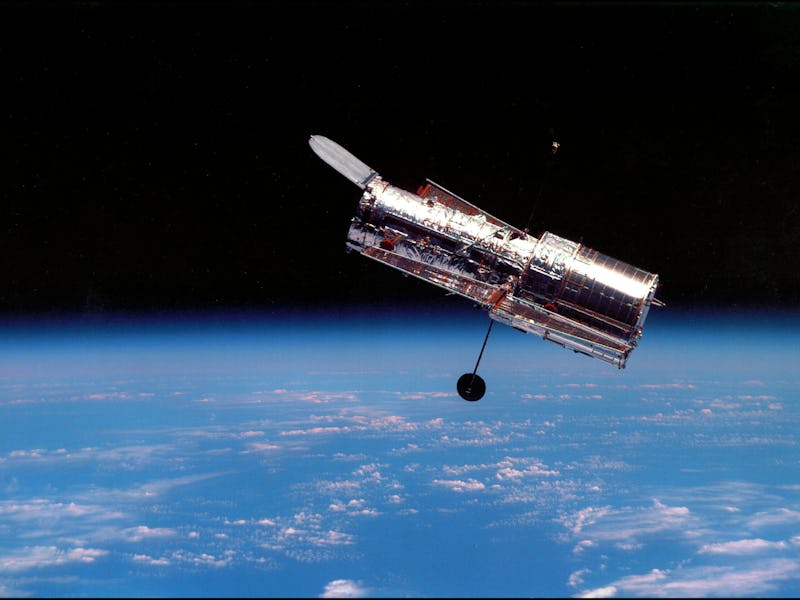NASA's Hubble Space Telescope woes reveal an even bigger flaw
The 30-year-old telescope is ailing — and with it goes some unique capabilities.

NASA is still scrambling to save Hubble.
After an unexpected error in one of the Hubble Space Telescope’s computers on June 13, NASA has been unable to return it to an operable state.
The issue started when the telescope's payload computer, which controls all scientific instruments and helps process the data collected, stopped sending the main spacecraft computer a “keep-alive” signal, which indicated normal operation.
NASA originally thought that the problem stemmed from a memory module, which stores the software necessary to operate the telescope’s scientific equipment. But after unsuccessfully trying to restart the module and switch to the backup modules three times over the last 10 days, the Hubble team has started to look at other components on the spacecraft.
NASA is now running tests to figure out whether an error in the payload computer’s processor or the interface connecting the computer’s components is to blame.
If there’s an issue with either of these components, the Hubble team can theoretically switch to a backup computer’s processor and interface hardware.
This payload computer —and the larger Science Instrument Command and Data Handling unit (SIC&DH) it's located inside — isn’t the original launched with the Hubble in 1990. It was installed in 2009, months after a glitch crippled the Hubble. Luckily, at the time the STS-125 Atlantis mission was already planned to service the telescope.
The mission replaced the computer and added the backup, along with upgrades to the telescope’s ultraviolet and infrared capabilities. There is no such mission planned now.
The James Webb Space Telescope could pick up some of Hubble’s slack. If it ever launches.
What happens if NASA can’t fix the Hubble?
Right now, there’s no other telescope that does exactly what the Hubble can do. Hubble specializes in capturing visible, infrared, and ultraviolet light. It’s a flexible and general telescope, kind of like the Swiss Army Knife of celestial surveying.
NASA’s other space telescopes tend to be more specialized:
- The Chandra X-ray Observatory and NuSTAR telescopes specifically capture images of the X-rays generated by the universe’s most extreme conditions, like exploding stars and black holes.
- The Neil Gehrels Swift Observatory and Fermi Gamma-ray Space Telescope focus on powerful gamma rays created by neutron stars, supernovas, and black holes.
- Others like the Transiting Exoplanet Survey Satellite have specific missions, like the discovery of exoplanets.
The closest space telescope NASA has in its arsenal hasn’t yet launched: the James Webb Space Telescope. It’s famously billions of dollars over budget and years behind schedule, but that might not matter if it can partially fill the void left behind by a malfunctioning Hubble. It is scheduled to launch later in 2021, potentially in November.
The Webb will be able to take over Hubble’s infrared and near-infrared capabilities. As NASA’s website explains, visible light allowed Hubble to photograph the infamous Eagle Nebula, but infrared light has allowed us to peer into the nebula’s dust cloud to see the stars within and beyond it.
Hubble’s visible light capability makes it unique for a current NASA space telescope, and where NASA would be most deficient in its absence. Since Earth’s atmosphere filters out most light except that in the visible spectrum, space telescopes have traditionally specialized in the infrared light not available on Earth.
As MIT Tech Review pointed out last time the Hubble was on the fritz, the telescope’s ability to capture visible light has proved crucial to scientific exploration. Its infrared and visible light images are cited in confirming the aftermath of the neutron star crash that allowed scientists to detect gravitational waves.
The only American space telescope in serious contention that would capture visible light is the Luvoir telescope, which is still in the proposal stage and would launch in the 2030s.
That means to capture visible light after the Hubble’s demise, NASA would have to rely on ground telescopes it partners with, like the Keck Observatory in Hawaii, the Gemini Observatory in Chile, or the South African Large Telescope, or upcoming large telescope projects like the European Extremely Large Telescope.
It wouldn’t be the first time that ground telescopes have helped NASA spacecraft — the Keck Observatory helped the Cassini mission in 2017 by photographing Saturn’s rings.
The Pillars of Creation, one of Hubble’s most famous photos.
What happens next? — With an entirely redundant payload computer, it seems unlikely that the Hubble is done for good. NASA says that if it’s necessary to switch to the alternate hardware, it will take “several days” to boot, make sure everything works correctly, and resume conducting science.
Errors also happen every few years, and NASA has usually been able to fix them up in a matter of days.
However, there’s another unknown: If the backup computer is needed this time, it hasn’t been switched on since it was installed in 2009. If that computer also doesn’t work, there’s no mission currently set to service the telescope — nor a spacecraft capable of intercepting Hubble in orbit.
NASA has been sending frequent updates about the team’s efforts to revive the Hubble, so it’s likely we won’t have to wait too long to find out whether the telescope is borked.
If this current error is resolved, NASA expects to ride the Hubble through the 2020s, potentially into 2030.
“The most recent estimates say that there’s an excellent chance we’re going to be doing science like we do today until at least 2026, and perhaps the whole decade,” Tom Brown, mission head for the Hubble told MIT Tech Review earlier this year.
This article was originally published on